Description of varieties of purple roses, planting, growing and care
Purple or lilac roses are demanding to care for, but they are very popular. They are often used in landscape design. The variety of varieties of purple roses is great. They have different shades, flower sizes, number of petals. There are light purple and dark purple varieties.
Are there purple roses
Purple roses are not found in nature. Varieties with this color were bred by breeders. They inserted a gene from pansies into the plant's genotype. The purity of the purple color has not been achieved. These varieties have a lilac hue.
Important! The color changes depending on the growing conditions of the bush: sunlight, watering, flowering stage.
Varieties of purple roses
Breeding purple roses took a long time, but many varieties with this shade were bred. The most popular types are described below.
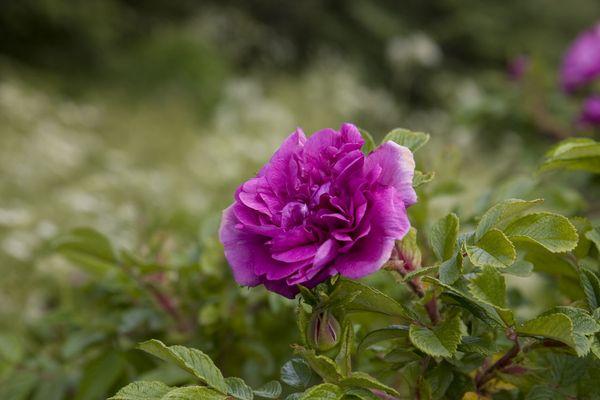
Rhapsody in blue
The bush reaches a height of 1.5 meters, straight. The flowers are lush, double, the petals are bright purple. More than 5 buds are formed on one branch. Has a delicate, pleasant aroma. At the bud stage, the petals are dark, almost blue. Later they fade in the sun and brighten. The variety is resistant to diseases and low temperatures.
Cardinal de Richelieu
One of the first purple rose varieties. It reaches a height of 2 meters. The bush is high, straight. There are no thorns on the stems. Single or group buds are formed on the branches. More often the second option. The flowers are large, dark lilac in color, the core is white. The petals are wavy, the buds seem to be double. Has a sharp specific aroma. Long bloom, but once a season. This variety is resistant to temperature drop, has strong immunity.
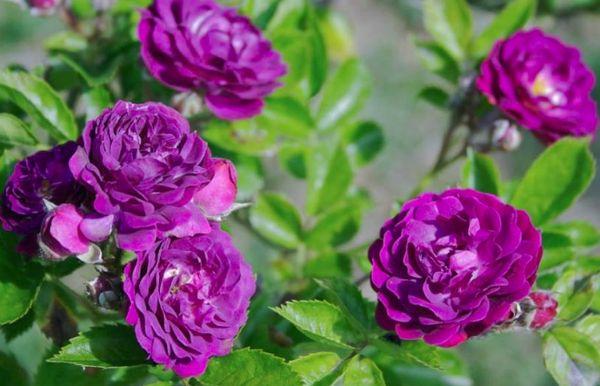
Blue for you
The bush reaches a height of 1 meter. The leaves are dark green, the shoots are straight, elongated. 3-4 buds are formed on one branch. They are closely spaced next to each other, together they look like a pink bouquet. The flowers are not very large, but there are many of them on the bush. The petals are wavy, have a light lilac shade. The peculiarity of this variety is its pleasant smell.
Low temperatures are poorly tolerated, prone to infectious diseases, due to unstable immunity.
Migdnight Blue
The bush is dense, reaches a height of 1 meter, compact. This variety blooms very profusely, even in the first year. 5-7 buds are formed on one branch. The leaves are bright green. The petals are wavy, forming the doubleness of the flower. The core is light yellow. The variety is dark purple in color. The scent is reminiscent of cloves.
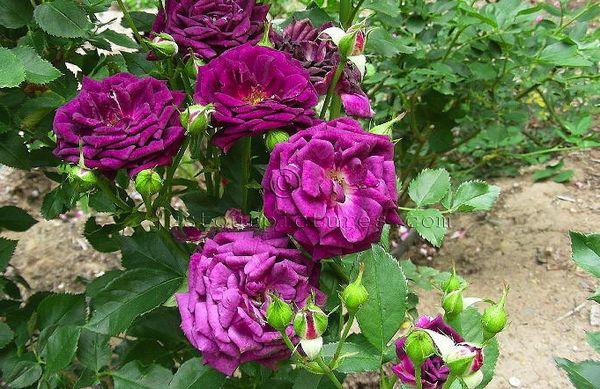
Novalis
The bush reaches a height of 80 centimeters, straight, compact. Several buds are formed on one branch. Repeated blooming is possible during the season. The petals are wavy. The flowers are large, light purple in color. They have a low aroma. One flower contains about 40 petals. The leaves are not large, green, glossy. The bush is resistant to diseases, but does not tolerate low temperatures and waterlogged soils very well.
Purple eden
The bush reaches a height of 80 centimeters, compact, straight. 5-7 buds grow on one branch. It blooms several times during the season. The leaves are dark green, medium in size. The flowers are dark purple, velvety. Terry petals, about 50-70 per flower. Has a bright clove aroma. The bush is resistant to diseases and low temperatures.
Necessary conditions for growing
Like any other plant, purple roses have their own growing characteristics. For long-term flowering, it is necessary to monitor watering, illumination, humidity, temperature conditions.
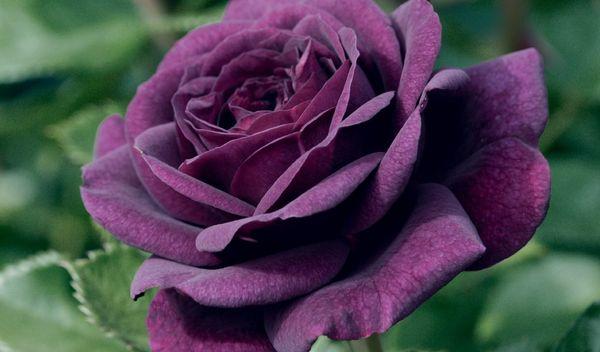
Lighting
Bushes love bright lighting, which should last 6-8 hours a day. The place should be open and not shaded. Do not plant roses next to a canopy and tall trees. If there is insufficient light, the plant may die, and the flowering will be poor. The place for planting roses should be well ventilated, but not in a constant draft.
Watering
It is necessary to water the bushes 1-2 times a week. Much depends on air temperature and humidity. If it rained the day before, then watering can be postponed, if drought - increase up to 3 times a week. 1 bush requires 10 liters of water. Watering is carried out early in the morning or in the evening. It is impossible to pour roses, this will lead to rotting of the roots and a decrease in immunity.
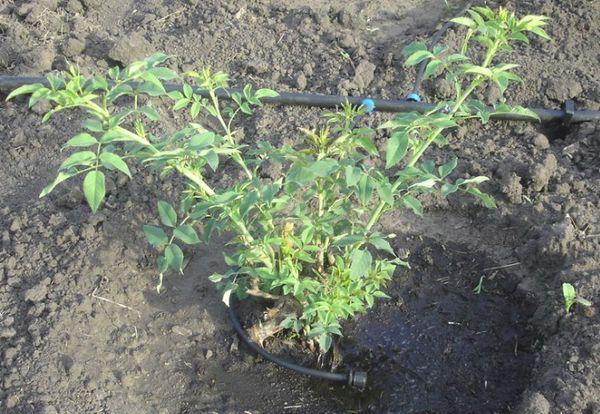
Temperature
The optimum temperature for roses is 26 ° C. If the season is hot, then the watering of the plant is increased. If the temperature drops below 0 ° C, then the bushes are covered with cellophane wrap. If this is not done, then by the next season they will freeze out. Some of the stems will die. It will take a long time to recover a frozen plant.
Humidity
The optimum humidity range for roses is 50-56%. With this indicator, the plant develops well, blooms, and dangerous fungi and bacteria do not show activity. With increased moisture, the immunity of roses decreases, microorganisms actively multiply and the bush can get sick.
Features of planting and care
In order for lilac or purple roses to take root on the site and give many bouts, you must follow the rules for planting and caring for them.

Planting roses
Dig planting holes with a depth and diameter of 50 centimeters. If the bush is large, then increase to 70 centimeters. Before planting, prepare a nutrient mixture:
- humus;
- manure;
- priming.
Before disembarking, water is poured into the pit so that it is completely absorbed. If the roots of the plant are in the ground, then they do not need to be cleaned; if they are clean, then they are pruned by a few centimeters. Immerse in a solution with a root growth stimulant for 120 minutes.
Important! The roots of the plant should not interact with fertilizers, so they are sprinkled with earth.
The seedling is immersed in a hole, sprinkled with soil, tamped so that there are no gaps with air in the roots. Then sprinkle with soil again. Hilling 10-15 centimeters from the ground. After 14 days, the resulting slide is removed. During this time, the seedling will take root.
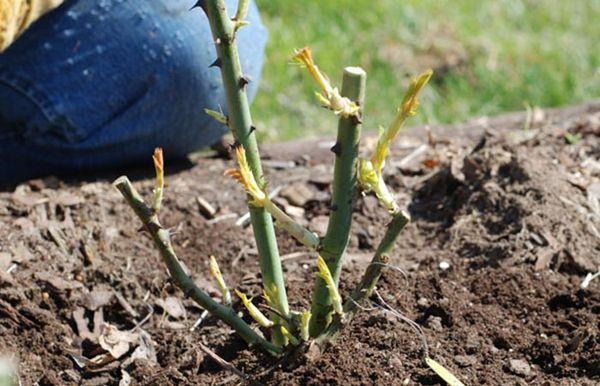
Top dressing
It is best to use horse manure half a year ago. Fresh manure releases a lot of nitrogen, which accumulates in the soil and destroys the plant. Top dressing depending on the growing season:
- Flowering period - calcium nitrate (1 tablespoon per 10 liters of water).
- Active growth and development - herbal infusions, mineral fertilizers, chicken droppings. Water every 2 weeks.
- The end of flowering - you cannot feed.
Prevention of infections
To prevent infections, plant leaves are sprayed with soda solution 2-3 times a week.The solution is prepared at the rate of 40 g of soda per 1 liter of water. A solution of laundry soap saves from aphids. On a bucket of boiled water, dissolve a bar of soap, add a few twigs of wormwood. The plant is sprayed once a season.
It is also recommended to plant onions, garlic, calendula, marigolds next to roses. They scare off gnawing insects.
The use of purple roses in landscape design
For landscaping, purple roses are used as accent or main plants. Grown as a sound barrier along the fence. Looks great as hedges and walls. Lilac roses are used to decorate gazebos, arches. Stand out as background plants in gardens and flower beds.

The combination of tall and low shrubs forms the backdrop for single plants in a flower bed. For barrier design, tall varieties are selected so that they overlap the main fence. The bushes will not only decorate the garden, but also create sound insulation.
As the main plant, roses form the basis of the garden. Plants are planted depending on the growth. Low plants are planted next to tall plants so that they do not overlap. Given the seasonality of purple roses, evergreen shrubs must be included in the composition.









